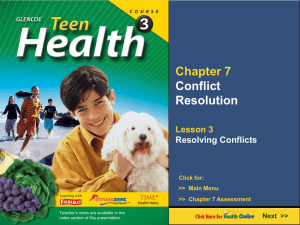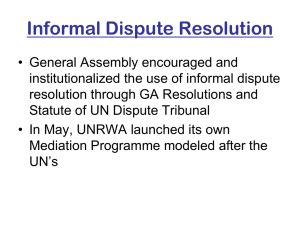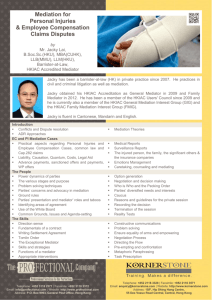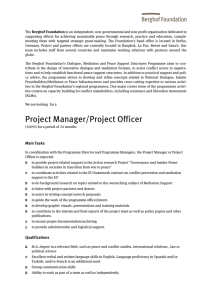Mediation process for workers compensation
advertisement
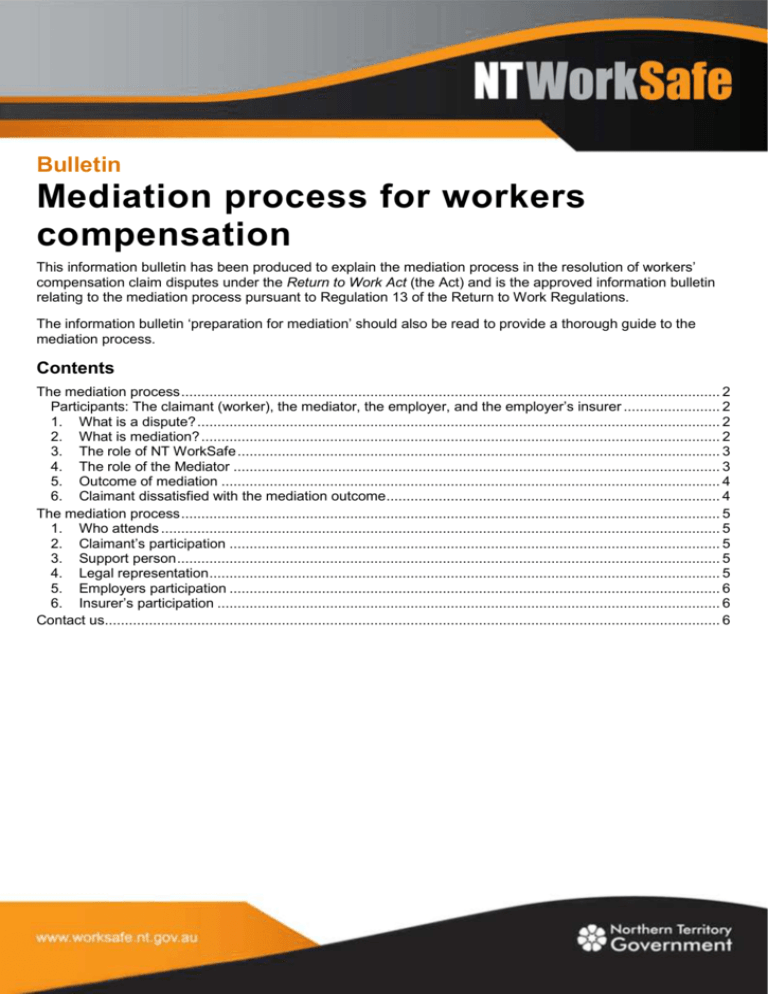
Bulletin Mediation process for workers compensation This information bulletin has been produced to explain the mediation process in the resolution of workers’ compensation claim disputes under the Return to Work Act (the Act) and is the approved information bulletin relating to the mediation process pursuant to Regulation 13 of the Return to Work Regulations. The information bulletin ‘preparation for mediation’ should also be read to provide a thorough guide to the mediation process. Contents The mediation process ...................................................................................................................................... 2 Participants: The claimant (worker), the mediator, the employer, and the employer’s insurer ........................ 2 1. What is a dispute? .................................................................................................................................. 2 2. What is mediation? ................................................................................................................................. 2 3. The role of NT WorkSafe ........................................................................................................................ 3 4. The role of the Mediator ......................................................................................................................... 3 5. Outcome of mediation ............................................................................................................................ 4 6. Claimant dissatisfied with the mediation outcome ................................................................................... 4 The mediation process ...................................................................................................................................... 5 1. Who attends ........................................................................................................................................... 5 2. Claimant’s participation .......................................................................................................................... 5 3. Support person ....................................................................................................................................... 5 4. Legal representation ............................................................................................................................... 5 5. Employers participation .......................................................................................................................... 6 6. Insurer’s participation ............................................................................................................................. 6 Contact us......................................................................................................................................................... 6 The mediation process Participants: The claimant (worker), the mediator, the employer, and the employer’s insurer 1. What is a dispute? Section 103B of the Act states that a dispute arises where a worker is aggrieved by the decision of an employer, which is usually the decision of the insurer – (a) to dispute liability for compensation claimed by the claimant (b) to cancel or reduce compensation being paid to the claimant, or (c) relating to a matter or question incidental to or arising out of the claimant’s claim for compensation. Mediation time limit Note: Under (a) and (b) above, a worker has 90 days from receipt of the insurer’s Notice of Decision and Rights Appeal form to apply to NT WorkSafe for mediation if there is a dispute. Under (c) above, there is no time limit to apply. Workers are encouraged to lodge a request with NT WorkSafe for mediation as soon as possible after the dispute arises. 2. What is mediation? Mediation may help solve disputes by sharing information and documents, identifying the issues in dispute, discussing them and trying to reach a mutually acceptable agreement. It is a fair, informal, quick service and is offered for free. How to apply for mediation An injured worker who has attempted to resolve a dispute and is dissatisfied with the outcome may apply to NT WorkSafe to have the dispute referred to mediation. An application for mediation must be in writing and may be emailed, posted, hand-delivered, or faxed to NT WorkSafe. To assist you in applying for mediation, the insurer may provide you with a Notice of Decision and Rights of Appeal request for mediation form and there is also an ‘Application for mediation form’ available on the NT WorkSafe website. 2 Approved information bulletin pursuant to Return to Work Regulation 13 for mediation process for workers compensation (V1.5 – 1 October 2015) Requests for mediation should be provided to NT WorkSafe by: Hand deliver: Post: NT WorkSafe First Floor Darwin Plaza Building 41 Smith Street, The Mall Darwin NT 0800 Request for Mediation GPO Box 3200 Darwin NT 0801 Email: Fax: mediationworksafe@nt.gov.au (08) 8999 5141 The worker may contact the workers rehabilitation and compensation section in NT WorkSafe on 1800 250 713 for assistance with their application. Interim benefits The worker may apply to the Work Health Court for interim benefits (wages) at any time after they have applied for mediation. For further information contact the Work Health Court on (08) 8999 7280. Note: The worker should be aware that if their claim is subsequently denied, action might be taken to recover these benefits from the worker. Claimant’s role Once the request for mediation is lodged the worker must ensure that they are available during the 21 days to supply any additional information that may assist the mediator in resolving the dispute. This is especially important where it appears to the mediator that a conference needs to be convened to assist in the resolution of a dispute. If a mediator decides to convene a mediation conference, participation is compulsory. 3. The role of NT WorkSafe After NT WorkSafe receives the request for mediation, a mediator is appointed within 7 days. NT WorkSafe will also, by notice in writing, require each party, being worker, employer and employer’s insurer, to provide within 7 days: All written medical reports in the party’s possession or control relevant to the dispute, including reports on which the party does not rely, and All other written material in the party’s possession or control on which the party relies. On receipt of this information NT WorkSafe will provide the reports and other material to the mediator and will assist them in making copies available to parties in the course of the mediation. 4. The role of the Mediator Once appointed, the mediator has 21 days to progress and complete the mediation process. The mediator is required to be independent, fair and impartial. The mediator will assist discussion, keep control of the process and assist the parties to reach agreement. If required, the mediator may make recommendations to assist either party to resolve the issue/s under dispute. Additional information The mediator may contact the worker regarding any additional information that may be available to assist in resolving the dispute. This additional information will be passed on to the insurer. The insurer may reconsider the claim, taking into account the additional information provided. Mediation conference If in the opinion of the mediator, a conference would help resolve the matter then the mediator will convene a mediation conference and require the worker, the insurer and the employer to attend. 3 Approved information bulletin pursuant to Return to Work Regulation 13 for mediation process for workers compensation (V1.5 – 1 October 2015) A worker is entitled to have a support person (who is not a lawyer) attend the conference with them such as a union representative, a family member or a friend. The support person can only represent the worker if the mediator is satisfied that to do so would facilitate the conduct of the mediation and the mediator has notified all other parties that the worker will be represented by the support person during mediation. Legal representation The legislation provides that the mediator may allow a lawyer to represent the worker in certain circumstances. The mediator may agree to the worker being legally represented if satisfied that it is physically impractical for the worker to participate in the mediation or the mediator is satisfied that to do so would facilitate the conduct of the mediation. If the decision is made by the mediator to allow legal representation then the mediator must notify all other parties of this representation. Reasonable cost of legal representation If the dispute relates to liability for compensation claimed by the worker or a decision to cancel or reduce compensation being paid to the worker, and the mediator agrees to the worker being legally represented the mediator may recommend to the Authority that the employer be directed to pay the reasonable costs of the legal representation and/or the reasonable costs of legal advice. The maximum amount of the reasonable costs payable by the employer will not exceed the amount of average weekly earnings at the time of the recommendation. The Authority will respond to the mediator’s recommendation either by: written notice to the employer (insurer) directing that they pay the reasonable costs of the legal representation and legal advice, or written notice to the claimant and the mediator informing them that the Authority has made a decision not to follow the recommendation. 5. Outcome of mediation Mediation may result in: the reasons for a decision becoming clearer or better understood by the worker, the decision being changed, an undertaking by the insurer to reconsider their decision on receipt of further information, or no change to the decision. All parties will be advised in writing, in the approved form, by the mediator, of the outcome of the mediation including any recommendations. The written advice of the mediator is referred to as a Certificate of Mediation. 6. Claimant dissatisfied with the mediation outcome If a worker is dissatisfied with the outcome of the mediation process, they may then make an application to the Work Health Court. The application to commence Court proceedings should be made within 28 days from the date of receipt of the Certificate of Mediation. Note: Before making an application to the Work Health Court, the worker must first apply for, and complete, the mediation process. 4 Approved information bulletin pursuant to Return to Work Regulation 13 for mediation process for workers compensation (V1.5 – 1 October 2015) The mediation process 1. Who attends The worker, the insurer, and the employer are all parties to a mediation conference. While employers are a party under the Act they may not always have to attend unless directed by the mediator. The employer should speak with their insurer and the mediator about the benefits of the employer attending a mediation conference. If mediation is sought for reasons of a dispute with a return to work plan, the mediator would direct the employer to attend. The mediator may direct others to attend as required. A worker is entitled to have a support person attend the conference with them such as a union representative, a family member or a friend. The support person can only represent the worker if previously agreed by the mediator. If because of distance, it would be impractical for all parties to attend, the mediation conference may be conducted by a telephone conference. If the worker speaks another language other than English, or speaks English as a second language, the worker, insurer or mediator can request NT WorkSafe to arrange an interpreter. A lawyer can only represent the worker if previously agreed to by the mediator. 2. Claimant’s participation There is nothing that prevents a worker seeking legal advice, prior to the mediation conference, to assist a worker to articulate their dispute. At the conference, the worker will be asked to explain why they disagree with the insurer’s decision. The insurer will be asked to explain the reasons for their decision. Following this, the mediator will assist in identifying the matters actually in dispute; then, with both parties, endeavour to resolve those issues and, if possible, bring about agreement. This is an opportunity for the worker to present their case to the insurer in an impartial and informal atmosphere. If there is any additional information that may assist the claim, the worker should provide this to the mediator. 3. Support person A worker is entitled to have a support person (who is not a lawyer) attend the conference with them such as a union representative, a family member or a friend. The support person’s role is not to speak on behalf of the claimant but to attend as a physical presence of support. The support person can only represent (speak for) the worker if the mediator is satisfied that to do so would facilitate the conduct of the mediation. The mediator would notify all other parties that the worker will be represented by the support person during mediation. 4. Legal representation If the dispute relates to liability for compensation claimed by the worker or a decision to cancel or reduce compensation being paid to the worker, the mediator may agree to the worker being legally represented if satisfied that it is physically impractical for the worker to participate in the mediation or the mediator is satisfied that to do so would facilitate the conduct of the mediation. If the decision is made by the mediator to allow legal representation then the mediator must notify all other parties of this representation. 5 Approved information bulletin pursuant to Return to Work Regulation 13 for mediation process for workers compensation (V1.5 – 1 October 2015) 5. Employers participation Employers participation during mediation depends on the type of claim that is in dispute. If the dispute is related to a written return to work plan, then the employer would assist by identifying the issues in dispute, sharing information and documents and trying to reach a mutually acceptable agreement. An employer in developing a return to work plan must consult with the injured worker and the injured worker’s treating medical practitioner. This is to ensure that the employer does not make decisions regarding what a worker is capable of doing without understanding the restrictions that may be imposed by the treating medical practitioner. 6. Insurer’s participation The insurer’s role is to listen to the worker, to provide explanation and information to the worker regarding the decision under dispute, and to consider any new information that is provided. Contact us For further information please contact us on 1800 250 713, facsimile 08 8999 5141, via email at mediationworksafe@nt.gov.au or go to the NT WorkSafe web site at www.worksafe.nt.gov.au. 6 Approved information bulletin pursuant to Return to Work Regulation 13 for mediation process for workers compensation (V1.5 – 1 October 2015)

